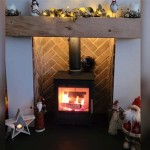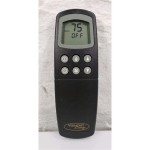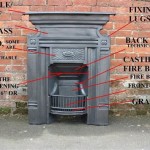Fireplace Flue Damper Repair: Maintaining Efficiency and Safety
The fireplace flue damper is a critical component of a functional and safe fireplace system. This metal plate, typically located just above the firebox, controls airflow through the chimney. A properly functioning damper seals the chimney when the fireplace is not in use, preventing heat loss during cold weather and keeping out unwanted pests and debris. Conversely, when the fireplace is in use, the damper opens to allow combustion gases and smoke to safely exit the home.
A damaged or malfunctioning damper poses significant risks. An open damper wastes energy, leading to higher heating and cooling costs. A stuck damper can prevent proper ventilation, causing smoke and dangerous carbon monoxide to back up into the living space. Therefore, understanding the signs of damper problems and addressing them promptly is essential for maintaining both the efficiency and safety of the fireplace.
Recognizing Common Fireplace Damper Problems
Identifying damper issues early is crucial for preventing further damage and ensuring safe operation. Several common problems can affect damper functionality. These include rust and corrosion, warping or bending, obstructions, and broken or malfunctioning operating mechanisms.
Rust and corrosion are frequent culprits, especially in older fireplaces or those located in humid climates. Moisture can accumulate within the chimney, leading to rust formation on the damper. This rust can cause the damper to seize, making it difficult or impossible to open or close. Over time, extensive corrosion can weaken the damper material, potentially leading to cracks or complete failure.
Warping or bending can result from excessive heat exposure or physical impact. Extreme temperatures generated during intense fires can cause the damper metal to deform. Physical damage, such as a falling object within the chimney or improper handling during cleaning, can also cause warping. A warped damper may not seal properly, resulting in air leaks even when closed.
Obstructions within the damper area can also prevent proper operation. Debris such as leaves, twigs, animal nests, and soot buildup can accumulate and interfere with the damper's movement. These obstructions can prevent the damper from fully closing, leading to heat loss and potential fire hazards. Regular chimney sweeping is essential to remove these obstructions and maintain proper airflow.
Broken or malfunctioning operating mechanisms are another common cause of damper problems. Many dampers are operated by a lever, chain, or rod that controls the opening and closing mechanism. These mechanisms can break or become damaged over time, rendering the damper inoperable. Common issues include broken chains, bent rods, and stripped gears. Identifying the specific type of mechanism and the nature of the damage is essential for proper repair.
Flue Damper Types and their Specific Repair Needs
Different types of flue dampers exist, each with its own design and specific repair requirements. Understanding the type of damper installed in a fireplace is vital for accurate diagnosis and effective repair.
The throat damper is the most common type, typically located directly above the firebox within the throat of the fireplace. These dampers are usually made of cast iron or steel and are operated by a lever located on the side of the firebox. Repairing throat dampers often involves addressing rust, corrosion, or warping. Replacement parts, such as levers and connecting rods, may be required if the operating mechanism is damaged.
Top-mounted dampers, also known as chimney top dampers, are installed at the top of the chimney. These dampers offer a tighter seal than throat dampers, as they seal the entire chimney opening. They are typically operated by a cable that runs down the chimney flue. Repairing top-mounted dampers can be more complex, often requiring roof access. Common issues include cable breakage, damage to the sealing gasket, and corrosion of the damper plate. Replacement of the entire damper assembly may be necessary in some cases.
Rotary dampers utilize a rotating metal plate to control airflow. These dampers are less common in residential fireplaces but may be found in some older installations. Repairing rotary dampers often involves addressing issues with the rotating mechanism or the sealing surfaces. Cleaning and lubrication of the moving parts can sometimes restore proper function. Replacement of the entire assembly may be required if the mechanism is severely damaged.
Modern energy-efficient fireplaces may incorporate specialized dampers designed to minimize air leakage. These dampers often feature insulated plates and tight-fitting seals. Repairing these advanced dampers may require specialized knowledge and access to specific replacement parts. Consulting with a qualified fireplace technician is recommended for these types of repairs.
Step-by-Step Guide to Damper Inspection and Minor Repair
Before attempting any repairs, it is imperative to ensure the fireplace is cold and that no hot embers or ash remain. Safety glasses and gloves should be worn to protect against debris and sharp edges. A flashlight is essential for illuminating the damper area.
The first step is a thorough visual inspection of the damper. Examine the damper plate for rust, corrosion, warping, or cracks. Check the surrounding area for obstructions such as leaves, twigs, or animal nests. Inspect the operating mechanism, including the lever, chain, or rod, for any signs of damage or wear.
If rust or corrosion is present, use a wire brush to remove loose rust particles. Apply a rust-inhibiting primer and paint to protect the metal from further corrosion. Be sure to use heat-resistant paint specifically designed for fireplace components.
For minor obstructions, carefully remove the debris using a brush, vacuum cleaner, or hand tools. Avoid using excessive force, as this could damage the damper. Ensure that all debris is removed from the damper plate and the surrounding area.
If the operating mechanism is stiff or difficult to move, try lubricating it with a silicone-based lubricant. Apply the lubricant to all moving parts, such as hinges, pivots, and connecting points. Work the mechanism back and forth to distribute the lubricant evenly. Avoid using oil-based lubricants, as they can attract dirt and grime.
If the damper is slightly warped, it may be possible to gently bend it back into shape. Use a pair of pliers or a metalworking tool to carefully straighten the damper plate. Avoid using excessive force, as this could cause the damper to crack or break. If the warping is severe, replacement of the damper may be necessary.
After completing any repairs, test the damper to ensure it is functioning correctly. Open and close the damper several times, checking for smooth and easy movement. Ensure that the damper seals tightly when closed, preventing air leakage. If the damper is still not functioning properly, more extensive repairs or replacement may be required.
When to Call a Professional for Fireplace Damper Repair
While some minor damper repairs can be performed by homeowners, certain situations require the expertise of a qualified fireplace technician. Attempting complex repairs without the proper knowledge and tools can be dangerous and could potentially damage the fireplace or chimney.
If the damper is severely damaged, such as with significant cracks, warping, or corrosion, replacement is usually the best option. Replacing a damper can be a complex task, especially for top-mounted dampers that require roof access. A professional technician has the necessary tools and experience to safely and efficiently replace the damper.
If the chimney has structural issues, such as cracks, missing bricks, or a damaged chimney liner, addressing these problems should take precedence over damper repair. A damaged chimney can compromise the safety of the fireplace system and could potentially lead to a fire or carbon monoxide poisoning. A professional chimney sweep or mason can assess the chimney's condition and recommend the appropriate repairs.
If encountering difficulties diagnosing the damper problem or determining the appropriate repair solution, consulting a professional is advisable. A qualified technician can accurately assess the situation and recommend the most effective and cost-efficient repair strategy. Attempting to guess at the problem or implement incorrect repairs can potentially worsen the situation.
If there are concerns about working at heights or with potentially hazardous materials, it is prudent to hire a professional. Working on a roof or handling corroded metal requires specific safety precautions. A qualified technician has the necessary safety equipment and training to perform these tasks safely and efficiently.
Regular chimney inspections are crucial for maintaining the safety and efficiency of a fireplace system. A professional chimney sweep can inspect the chimney, flue, and damper for any signs of damage or deterioration. They can also clean the chimney to remove soot and creosote buildup, which can prevent chimney fires. Schedule a chimney inspection at least once a year, or more frequently if the fireplace is used regularly.

Nicholas Chimney Sweeping Stove Fireplace Services Vienna Virginia

Fireplace Damper Repair Full Service Chimney Kansas City

Damper Repair Replacement Cherry Hill Mason S Chimney Serivce

How To Fix A Stuck Fireplace Damper The Blog At Fireplacemall

Damper Repairs Replacement Yamhill County Chimney

Fireplace Damper Repair Full Service Chimney Kansas City

Don T Let A Leaky Chimney Damper Dampen Your Spring American Masonry

What Does A Chimney Damper Do My Need One

Chimney Dampers In Chicago Capital Corp

Flueblocker Chimney Flue Fireplace Draft Stopper Herdwick Wool Damper Replacement 8 X 20 Com
Related Posts








